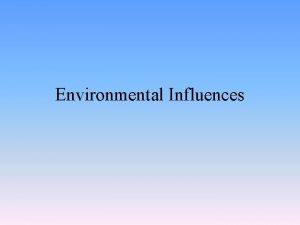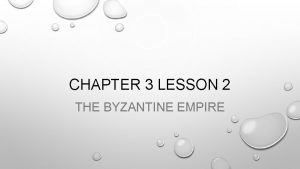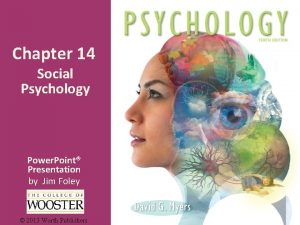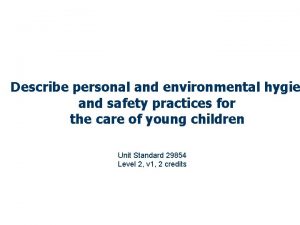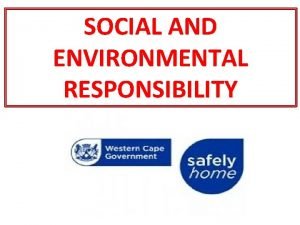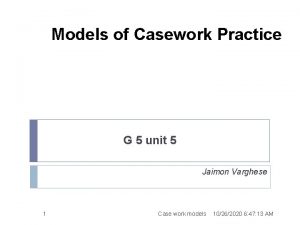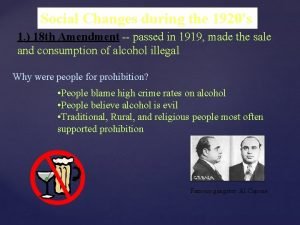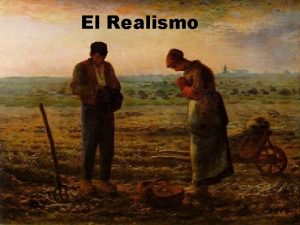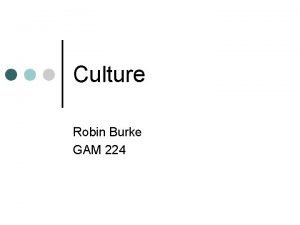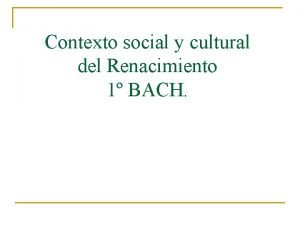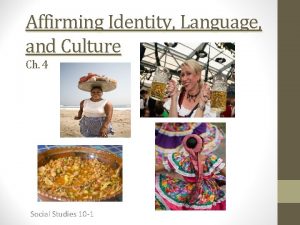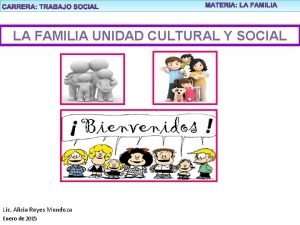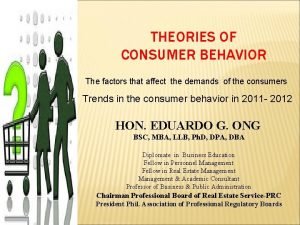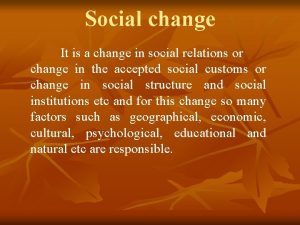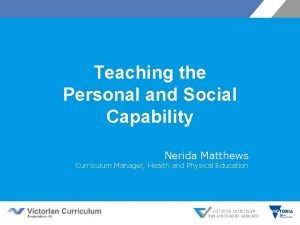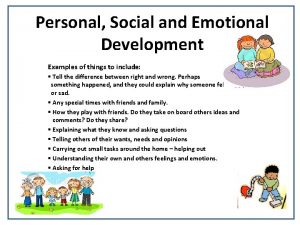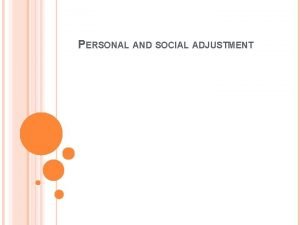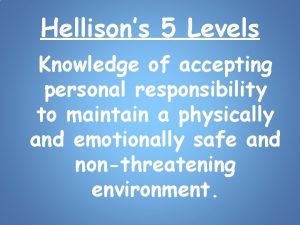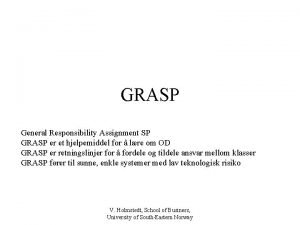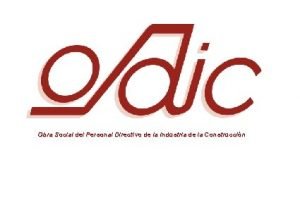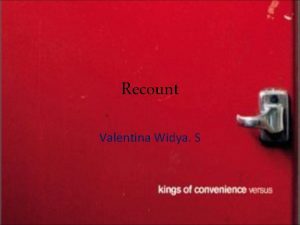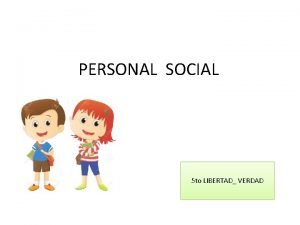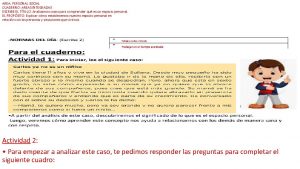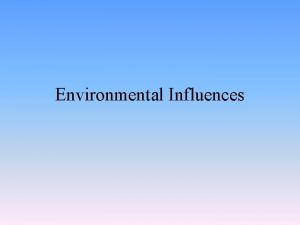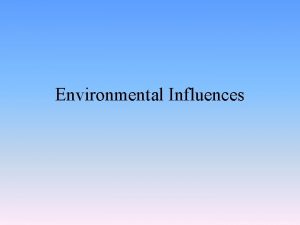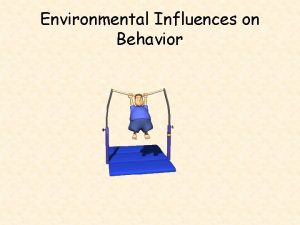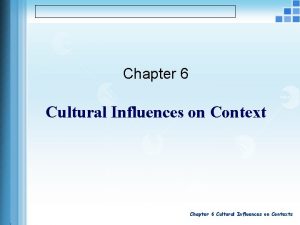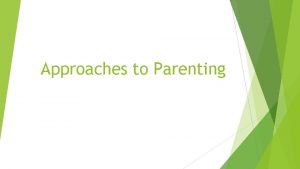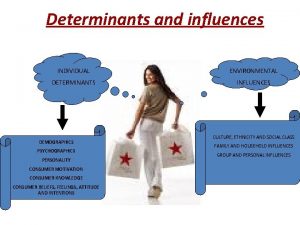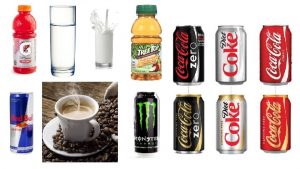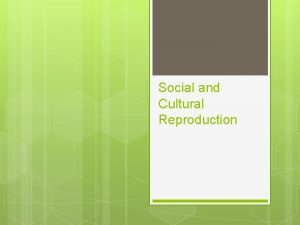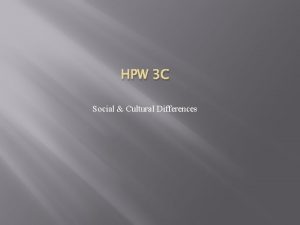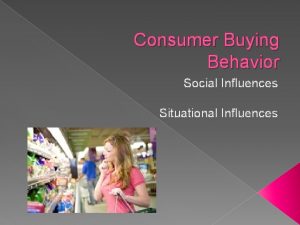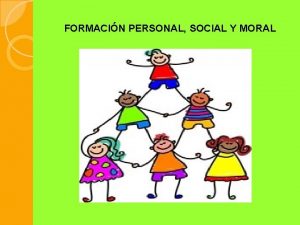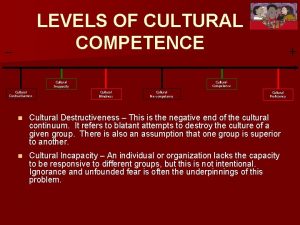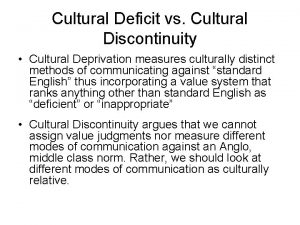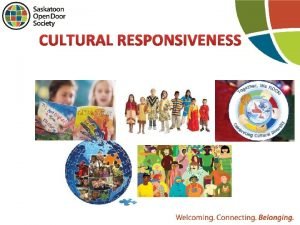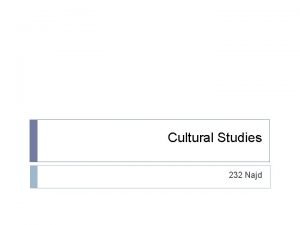ENVIRONMENTAL INFLUENCES TYPES OF INFLUENCES Cultural Social Personal















































- Slides: 47

ENVIRONMENTAL INFLUENCES

TYPES OF INFLUENCES Cultural Social Personal Family Situational

VALUES Values are shared beliefs or group norms internalised by individuals

NORMS Norms are beliefs held by consensus of a group concerning the behaviour rules for individual members

SOCIALISATION The process by which people develop their values, motivation and habitual activity. Consumer socialisation is the acquisition of consumption related cognitions, attitude and behaviour

WHAT IS CULTURE? A set of values , ideas and other meaningful symbols that help individuals communicate, interpret and evaluate as members of society Provides people with a sense of identity and an understanding of acceptable behaviour within society.

CULTURAL INFLUENCE Relationships Sense of self and space Values and norms Communication and language Beliefs and attitudes Dress and appearance Mental processes and learning Food and feeding habits Work habits and practices Time and time consciousness

HOW IS CULTURE PROPAGATED? Culture is learned – through imitation or by observing the process of reward and punishment in a society of members who adhere to or deviate from group norms. Culture is inculcated through family, religion and schools Culture rewards socially gratifying responses. When norms no longer provide gratification in a society, the norms are extinguished Culture is adaptive

CULTURE AFFECTS CONSUMER BEHAVIOUR Function Form Meaning

IMPACT OF CULTURE ON CONSUMPTION A nation’s culture determines what suppliers can offer, the way products can be marketed and the degree to which consumers are allowed to act on their preferences

HOW CORE VALUES AFFECT MARKETING? Defines how products are used in society Provide +ve or –ve valences for brands and communication programmes Define acceptable market relationships Define ethical behaviour

CHANGING INSTITUTIONS Declining Family Influence Changing Religious Influence Changing Education Institutions

INTERGENERATIONAL MOTIVATING FACTORS Consumers are products of their environment. People strive as adults to achieve what they believe they were deprived of in early stages of life. Cohort analysis helps us to understand the differences between different groups and their motivations

SOCIAL INFLUENCE Behaviour can also be influenced depending on social class

WHAT IS SOCIAL CLASS? It is defined as relatively permanent and homogeneous divisions in a society into which individuals or families sharing similar values, lifestyles, interests and behaviour can be categorised

SOCIAL STRATIFICATION When a large group of families are approximately equal in rank to each other and clearly differentiated from other families, they form a social class ‘Pecking Order’ Determined by class, status and caste

SOCIAL CLASSES ARE STRATIFIED ACCORDING TO THEIR RELATIONS IN THE PRODUCTION AND ACQUISITION OF GOODS Social status groups are stratified according to the principles of their consumption of goods as represented by their ‘style of life’

WHAT DETERMINES SOCIAL CLASS? Economic – Occupation, Income, Wealth Interaction – Personal Prestige, Association, Socialisation Political – Power, Class Consciousness, Mobility

HOW TO MEASURE SOCIAL CLASS? Objective Subjective Interpretiv e

PRETENDERS TO A SOCIAL CLASS ARE MUCH MORE THAN PEOPLE THAT FALL IN IT. Therefore, product usage does not necessarily mean that people fall in that class

DO SOCIAL CLASSES CHANGE? Men inherit the class of their father. Women can change class with marriage. Similarly women can lose status after divorce

PERSONAL INFLUENCE Personal influence, direct or indirect is one of the very best forms of persuasion. This is because the input from people with whom we can identify and relate can attain remarkable credibility.

TYPES OF PERSONAL INFLUENCE Reference group – Normative, Comparative WOM

MODELS OF PERSONAL INFLUENCE Trickle down theory Two step flow Multi-stage interaction

TYPES OF REFERENCE GROUPS Primary Vs. Secondary Aspirational Vs. Dissociative Formal Vs. Informal

FORMS OF REFERENCE GROUP INFLUENCE Normative Influence – when people conform and comply through pressure from reference group behaviour Value Expressive Influence – identification or enhanced image in the eyes of others Informational Influence – When assessment of products or services are difficult, people turn to others who have had or claim satisfaction with this product –’Principle of social proof’.

WORD OF MOUTH For WOM to spread it requires an opinion leader There has to be some motivations for spreading WOM

WHEN WILL WOM BE USEFUL? Consumer lacks sufficient information to make an informed choice Product is complex and difficult to evaluate using objective criteria Consumer lacks the ability to evaluate the product or service Other sources are perceived to be less credible An influential person is more accessible and can be consulted saving time and effort Strong social ties are present between transmittee and receiver High need for social approval

IDENTIFYING ‘INFLUENTIALS’ Sociometri c Key informant Selfdesignatio n

MOTIVATIONS FOR WOM Involvement Self Enhancement Concern For Others Message Intrigue Dissonance Reduction

IMPACT OF WOM COMMUNICATION Verbal vs visual information Source vs seeker initiated conversatio n -ve vs +ve information

MARKETING IMPLICATIONS Creating Influentials Targeting Influentials Stimulating +Ve WOM

FAMILY INFLUENCE Buying decisions of individuals may be heavily influenced by other members of the family or household

HOUSEHOLD All persons related or otherwise occupying the same dwelling unit. Non-family units would come under this category eg, singles, elderly people, POSSLQ, divorcees

FAMILIES CAN COMPRISE OF Nuclear Extende d

HOW DO FAMILIES FUNCTION? Cohesion Adaptability Communication

INDIVIDUAL ROLE IN A BUYING CENTRE Gatekeepe r Initiator Influencer Decider Buyer User

SPOUSAL BUYING ROLES Autonomic Husband dominant Wife dominant Syncratic (joint)

BEHAVIOUR CHANGES RELATED TO FAMILY LIFE CYCLE (FLC) Single-Newly Married – Full Nest II – Empty Nest II – Solitary Survivor – Retired Solitary Survivor Nature of products Priorities accorded to expenditure Habits and preferences

PARENTING STYLES Authoritarian Negligent Democratic Permissive

SITUATION INFLUENCES Arising from factors that are particular to a specific time and place that are independent of consumer and object characteristics

TYPES OF CONSUMER SITUATIONS Communication situations Purchase situations Usage situations

COMMUNICATION SITUATIONS Those settings where the consumer is exposed to either personal or non personal communications.

PURCHASE SITUATIONS Those settings in which consumers acquire products and services Information environment – availability, load, format, form Retail environment –atmospherics, music, layout, colours, POPs, salespeople, crowding Time

USAGE SITUATIONS Those settings in which consumption occurs: Location is same Location is different Used differently Different social situations Time of the day

PERSON-SITUATION INTERACTION Behaviour can also change depending on the type of consumers for the same situation

UNEXPECTED SITUATIONAL INFLUENCE Product out of stock Guests dropping in for dinner Sudden leave being sanctioned Falling ill For marketers, it is assumed that the no. of customers lost due to unexpected situational influences is offset by the number of customers gained by unexpected situational influences. While this may be true at an overall level, losses and gains could happen at a company/industry level
 Environmental influences
Environmental influences Environmental influences
Environmental influences Environmental influences on consumer behavior
Environmental influences on consumer behavior Example of cultural influences
Example of cultural influences Example of cultural influences
Example of cultural influences What cultural influences shaped the byzantines?
What cultural influences shaped the byzantines? Wireless health
Wireless health Social influences on consumer behavior
Social influences on consumer behavior Influence examples
Influence examples Social thinking and social influence
Social thinking and social influence Social thinking social influence social relations
Social thinking social influence social relations Personal community and environmental health
Personal community and environmental health What is personal and environmental hygiene
What is personal and environmental hygiene Global context orientation in space and time
Global context orientation in space and time Health social and environmental responsibility
Health social and environmental responsibility Campaign with responsibility project
Campaign with responsibility project Models of case work
Models of case work Responsibility center ppt
Responsibility center ppt Esj action plan
Esj action plan Moral social and cultural studies grade 9
Moral social and cultural studies grade 9 1920s social changes
1920s social changes Cual es el contexto social en el que surge el realismo
Cual es el contexto social en el que surge el realismo Cultural vs social
Cultural vs social Contexto social del renacimiento español
Contexto social del renacimiento español Cultural vs social
Cultural vs social Affirmation of identity social studies
Affirmation of identity social studies La familia unidad cultural y social
La familia unidad cultural y social Movimiento literario romanticismo contexto historico
Movimiento literario romanticismo contexto historico Discrepancy
Discrepancy Nature of social change
Nature of social change Cultural social
Cultural social Canada biome
Canada biome Que son formas no verbales
Que son formas no verbales Aseo personal adivinanzas de la higiene personal
Aseo personal adivinanzas de la higiene personal Ano ang tunay na misyon
Ano ang tunay na misyon Lewis model of cultural types
Lewis model of cultural types How to write a personal statement for university
How to write a personal statement for university Personal and social capability
Personal and social capability Fictional character examples
Fictional character examples Meaning of social adjustment
Meaning of social adjustment Don hellison's levels of personal and social responsibility
Don hellison's levels of personal and social responsibility Teaching personal and social responsibility
Teaching personal and social responsibility Personal social letras
Personal social letras Procesos didacticos de personal social
Procesos didacticos de personal social Factual recount
Factual recount Personal social
Personal social Cual es el cuaderno de integradas
Cual es el cuaderno de integradas Bob fosse influences
Bob fosse influences

